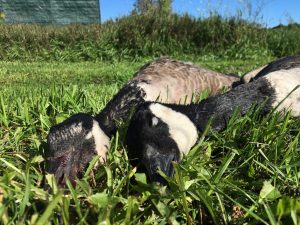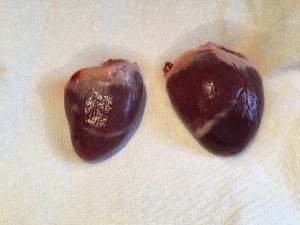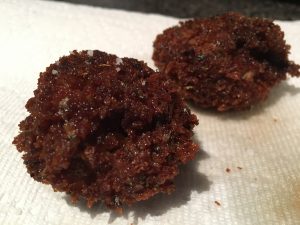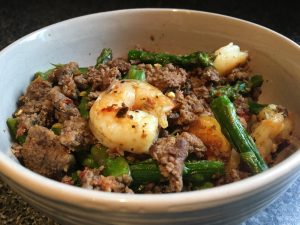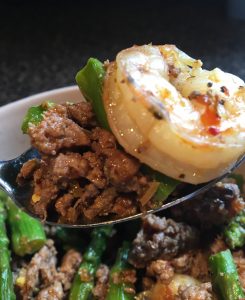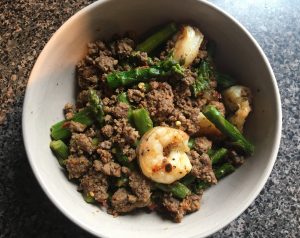We shot a lot of geese the other weekend, or as they say in the current vernacular we “made a pile”. In fact, that’s precisely what we did. In the tradition of almost every successful waterfowler since time immemorial we made a pile of dead geese, and we took a photo of it. It is without a doubt a common practice to take such a picture, in fact there are pictures of hunters and dead waterfowl going back for as long as there are photographs. I’ve heard people make a connection between ancient cave paintings of hunting and the act of taking photos, arguing that they share a common ancestry; I’ve always considered that to be a bit of a “reach”.
Regardless, in my advancing age, I’ve developed an increasingly tactful approach with my ‘pile pictures’ in the age of social media. In a pre-social media age, pictures of hunters grinning behind some stacked up mallards or a row of belly-up geese lived in print photo albums, pulled out for the occasional trip down memory lane, and then tucked safely and inoffensively away until the next time. But with the culture of sharing (and some might argue, over-sharing) prevalent, I’ve opted not to subject my non-hunting friends, coworkers, and acquaintances with big body counts on their Facebook, Twitter, and other news feeds. If they want to see that sort of thing, they’ll follow the website pages, and not my personal page. Which leads me to the handful of social media hunting forums I frequent, where I felt I was among brethren. It was there I posted an evening photo showing a tailgate-bending pile of sixty-two geese for their perusal. Just eight birds shy of our 14-man limit, we’d had a truly unforgettable hunt and I was generally, if not a little naively, certain that if there was feedback it would be positive, after all I really enjoy seeing other waterfowlers having success and I’m not shy with my Facebook ‘likes’.
I was more or less right, but one hunter took exception. He likened the photo to ‘market-hunting days’, labelled it disrespectful and twice called the character of myself and my friends (total strangers to him mind you) into passive-aggressive question. He said (I’m paraphrasing) that only through those kinds of interactions could waterfowlers “get better”. Now, it was certainly not metaphorically a mountain nor was it a molehill of chastising on his part, and since I really try not to argue with anyone on the internet I just kindly thanked him for his feedback and apologized in true Canuck fashion for my misreading of his sensibilities. Other hunters had the expected feedback, defending the photo, the hunt, and my responses, which was an unexpectedly pleasant outcome. In the end though, even that it all ended in a surprisingly respectful fashion, it did give me extensive pause for thought.
Because although I won’t stop shooting piles of geese, nor will I likely stop taking pictures of those piles of geese, objective self-assessment is healthy so here’s what I came up with.
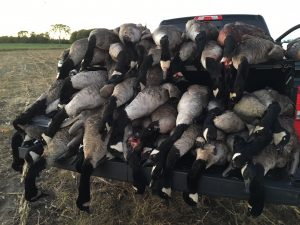
First off, waterfowlers ceasing their ‘pile pictures’ or ‘grip and grins’ or ‘hero shots’ or whatever you want to call them would only be constitute the situation getting “better” if you take as fact this anonymous commentator’s opinion that we are currently in a state that needs some manner of improvement…and I’m not so sure we are in that situation. After all it would certainly not be a faulty argument to state that ‘pile pictures’ give a nod to conservation. There was a time not too long ago when seeing 100 geese in a whole season would have been unthinkable, never mind shooting almost 100 in a weekend. To be certain there are several contributing factors to the current plentiful state of goose populations, and the efforts of hunters and other conservationists are surely part of that equation, so why not reap the bounty? All our geese get processed and eaten, and several recipes have graced this website previously (and more are coming) which would put us on the vanguard of field-to-table culture, and we have introduced many young kids to the tradition, future conservationists and hunters with awe in their eyes while hundreds of geese trade the skies and whirlwind into the decoys. So, excuse my ‘pile photo’ if it offends you, but sorry I’m not really that sorry.
That said, I’m not so pedantic to think that we as hunters should not temper our pride or prowess with an understanding that a whole lot of people don’t like to look at heaps of dead animals. I just hadn’t experienced it with and from other hunters. But such is the world we live in now. After all, just what are we exactly celebrating in this photo? We almost shot a limit, so do pile photos illustrate restraint, proof that we stayed under the legal maximum? Were there hints of vanity or an air of dominance of man over flying beast? Objectively, there probably is a sense of “Look at us and what we did!”, and in the submission to my peers I’d be lying if I said there was not validation sought and gained.
Of course, with every piece of technology now a camera, is it time we re-assess what hunting photos even are anymore. The old saying “photos or it never happened” seems haggard and overused, and more than once I’ve rued the requirement to accumulate images and engagements and that oh-so elusive “content”. There are so many of them, I don’t think I’m out of line to ask if all hunting photos are even celebrations anymore or are they just becoming the perfunctory and ubiquitous by-product of our time?
If I put myself in the mind of this commenter, I have even further questions. For example, in that individual’s eyes what would be the acceptable number of geese or ducks to show in a photo? Would it be zero? If it were to be zero, would that in some way sanitize the hunt or show some elevated level of respect for the birds? As much as I respect the non-hunter viewpoint when expressed rationally and respectfully, at the root of things to hunt is to kill. If we take the kill out of the medium and narrative, why take photos of anything? Why tell any stories? Nay, why hunt? Why anything at all?
Okay, so it got absurdly nihilist there for a moment but I’m back.
This all boils down to the theory I’ve had for years, and written about here clumsily, around what I call the Hypocrisy Line; that nebulous and elusive stage where the things you could reasonably participate in cross the line into the things you find offensive when others do them, but are still okay for you to do for no other reason than that you yourself are doing them and can use rational gymnastics to justify the act. It is the hunting embodiment of “Do as I say, not as I (might) do.”
There absolutely are hunting photos I find distasteful. I once saw a harvested wild turkey in close-up with half of its face blown clean off. That wasn’t for me. I found a photo of a legally-hunted rhino draped in an American flag. I had reservations and a few questions. There has always been something a little off to my eye about shooting and then posing with a lion or a giraffe or a leopard, but that’s a bias of my upbringing more than any deep-seated objection to the act. But in all those scenarios, and the sporadic others I see now and then, I’ve never been so incensed that I took it public with another hunter and their posting.
Because sometimes that’s hunting, warts and all. Also, I refer you to my earlier remark about not arguing with people on the internet.
Anyhow, I debated a bit about the ‘offending photo’ and whether I’d leave it up in the social media group. In the end I did, and I’ve put it in this post too, because if you’re reading this far you’re either very generous with your time for my rambling, or you’re in consensus with me. And if you’re not, that’s fine too; shout at me on the internet if you want.
I’ll probably not engage in the banter though.

